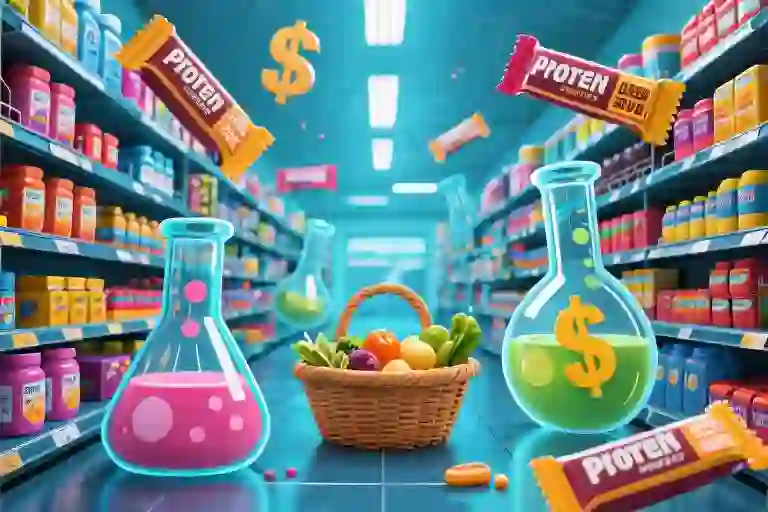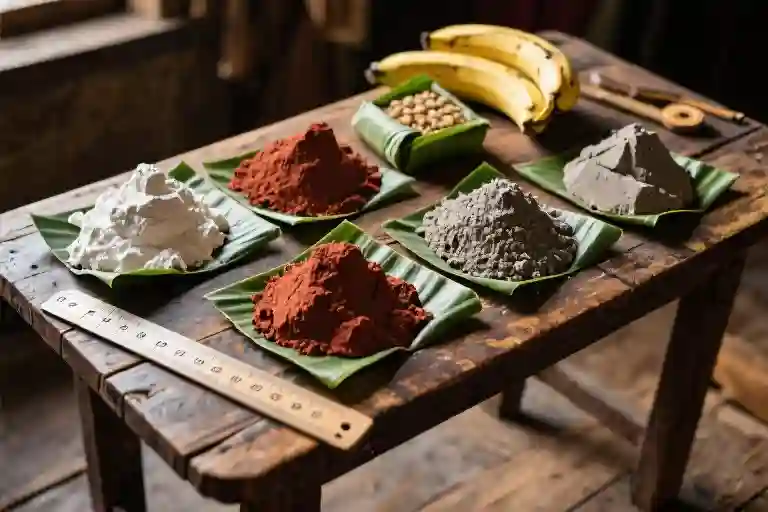The cereal box screams “20g protein per serving!” in bold letters. Your afternoon snack bar boasts “muscle-repairing plant protein.” Even your bottled water now comes with a “protein-infused” variant. We’ve reached peak protein absurdity, where every edible item seems desperate to prove its macronutrient worth.
This isn’t just about fitness culture anymore. Walk through any supermarket aisle, and you’ll find protein has become the ultimate health halo—a magical stamp that absolves even the most processed foods of their nutritional sins. That neon-colored drink powder? It’s “high-protein,” so it must be good for you. Those chalky-textured bars with ingredient lists longer than a CVS receipt? Packed with 28g protein, so obviously they belong in your gym bag.
Here’s what no one’s saying out loud: Protein has become the new “low-fat”—a marketing gimmick detached from actual nutrition science. The food industry knows we’re collectively terrified of not getting enough, despite most Americans consuming nearly double the recommended daily intake. They’ve turned a basic macronutrient into a status symbol, a virtue signal, a billion-dollar anxiety to exploit.
Take the latest David protein bars as Exhibit A. Their ads proudly declare an “astounding protein-to-calorie ratio,” a metric that sounds scientific until you realize it was invented by marketing departments. Yes, 28 grams of protein in 150 calories is technically impressive—if your only nutritional goal is hitting arbitrary macros while ignoring everything else your body needs.
This protein obsession comes at a cost we rarely discuss. When we equate “high-protein” with “healthy,” we give food manufacturers permission to load products with isolated proteins, artificial sweeteners, and gut-irritating thickeners—all forgiven under the protein halo. We start viewing foods as mere protein delivery systems rather than, well, food.
Perhaps most ironically, this frenzy happens while actual protein deficiency remains extremely rare in developed countries. The real deficiency? Critical thinking about what we put in our bodies. Because when a bag of cheese puffs can rebrand as a “protein snack,” we’ve clearly lost the plot.
Protein Mania: When Marketing Hijacks Nutrition
The cereal aisle tells a curious story these days. Where once we had simple cornflakes and bran, now shelves groan under the weight of protein-enriched everything – from pancake mix to instant oatmeal boasting 20 grams per serving. Walk down any supermarket aisle and you’ll find protein water next to vitamin water, high-protein chocolate bars nudging against regular candy, even protein-packed ice cream freezers. According to industry reports, new high-protein product launches surged 67% last year alone.
This protein obsession has birthed some truly bizarre creations. There’s collagen-infused coffee for your morning protein fix, protein-enhanced potato chips for ‘guilt-free’ snacking, and my personal favorite – protein water that somehow manages to be both cloudy and flavorless while promising muscle growth. The most telling statistic? A recent consumer survey found 85% of respondents automatically equate ‘high-protein’ labels with healthier choices, regardless of what else lurks in the ingredients list.
What’s fascinating isn’t just the proliferation of these products, but how completely we’ve accepted protein as the ultimate nutritional currency. The marketing has been so effective that we no longer question whether adding protein to everything makes sense – we just assume it must. Never mind that our great-grandparents built perfectly functional muscles without protein-fortified bagels or amino acid-laced sports drinks.
The protein push reveals how thoroughly food marketing has rewritten our nutritional instincts. Where nutritionists see one macronutrient among many, consumers now see a magic bullet – and food companies are all too happy to sell it back to us at premium prices. Those chalky protein bars that taste like sweetened sawdust? Suddenly worth $4 each because the wrapper shouts about 30 grams of protein. Never mind that you could get the same from a $1 chicken thigh and actually enjoy eating it.
This isn’t to say protein isn’t important – it absolutely is. But somewhere between legitimate nutritional science and the grocery store shelf, we’ve lost perspective. The current protein mania says less about our actual dietary needs than about our vulnerability to clever marketing and our perpetual hope for simple solutions to complex health questions.
The Three Great Lies of Protein Marketing
Walk down any grocery aisle today and you’ll be bombarded by promises – protein cereal that ‘fuels your day’, protein water to ‘rebuild muscles’, even protein-packed cookies that somehow qualify as ‘health food’. This isn’t nutrition science at work; it’s marketing departments exploiting our collective protein anxiety.
Lie #1: “High-Protein” Equals Healthy
That granola bar shouting about its 15g protein? Turn it over. You’ll likely find a chemistry experiment – soy protein isolate, whey concentrate, and enough emulsifiers to stock a lab. The food industry discovered something remarkable: slap ‘high-protein’ on a label, and suddenly we overlook the fact that we’re eating ultra-processed food with the nutritional integrity of cardboard.
Take the popular PowerCrunch bars. Their front label boasts ’20g complete protein!’ while the ingredients list reads like a industrial food additive manual: maltitol syrup, palm kernel oil, and no less than three types of protein isolates. Yet consumers happily pay premium prices, convinced they’re making a healthy choice.
Lie #2: The Protein-to-Calorie Ratio Scam
Here’s how the scam works: Take a David protein bar with 28g protein and only 150 calories. Divide protein by calories (28/150=0.187), then market this meaningless number as revolutionary. Never mind that our bodies don’t absorb or utilize protein this way.
This fake metric exists for one reason – to make processed foods appear superior to whole foods. A chicken breast’s ‘protein ratio’ can’t compete because nature includes things like fat and water. Food scientists simply remove everything but protein, then claim their Frankenfood is ‘more efficient’.
Lie #3: The Muscle Repair Mirage
Protein supplement ads show chiseled athletes, implying their gains came from powders and bars. What they don’t show: the balanced meals, rest days, and years of training.
“Muscle synthesis requires carbs for energy, fats for hormone production, and micronutrients most processed protein products lack,” explains Dr. Elena Rodriguez, sports nutritionist. “We’ve created a generation that thinks pouring protein powder on terrible eating habits will give them abs.”
The truth? Unless you’re an Olympic athlete, that $4 protein bar probably isn’t doing anything a handful of almonds couldn’t – except draining your wallet faster.
The Overlooked Science Behind Protein Hype
The numbers don’t lie – most of us are consuming far more protein than our bodies actually need. Recent nutritional surveys show the average person’s daily protein intake exceeds recommended levels by 42%, yet food companies continue pushing the narrative that we’re all deficient. This manufactured anxiety fuels the endless cycle of protein bar purchases and powder subscriptions.
What gets lost in this protein frenzy are the very real health consequences. Multiple peer-reviewed studies in the American Journal of Clinical Nutrition found that sustained high protein intake forces kidneys to work 31% harder during filtration processes. Emerging research also links excessive processed protein consumption to gut microbiome disruption, particularly reductions in beneficial bifidobacteria strains.
The automotive world provides a useful analogy for understanding protein’s proper role. Imagine macronutrients as car components: proteins are like spark plugs (essential for ignition), carbohydrates serve as fuel, and fats act as lubricants. No mechanic would suggest installing extra spark plugs improves performance – the system requires balanced proportions. Yet this is precisely what protein marketing encourages us to do.
Three critical truths about protein often get buried:
- The diminishing returns principle – Muscle protein synthesis plateaus at about 0.4g per pound of body weight daily. Everything beyond that either gets excreted or stored as fat.
- The amino acid profile matters more than quantity – Many processed protein products use incomplete proteins that lack essential amino acids found in whole foods.
- Metabolic flexibility suffers – Relying heavily on protein for energy forces the body to abandon its natural ability to switch between fuel sources efficiently.
Perhaps most ironically, the populations most susceptible to protein marketing – fitness enthusiasts and weight-conscious individuals – often benefit least from excessive intake. The human body simply doesn’t operate on a ‘more is better’ principle when it comes to any single nutrient, protein included.
This isn’t to villainize protein supplements entirely. There are legitimate uses for them in certain medical conditions or extreme athletic training. But for the average person eating a varied diet, the relentless pursuit of extra protein serves corporate profits far more than personal health.
Navigating the Protein Aisle Without Falling for the Hype
The fluorescent glow of protein bar wrappers stares back at you from every checkout counter, each promising to transform your health with astronomical protein numbers. Before reaching for that neon-packaged ‘muscle fuel,’ let’s talk about decoding the real story behind these labels.
The Three-Second Ingredient Scan
Flip any protein product around and your eyes should immediately go to three things: the order of ingredients, the additive codes, and the ratio of recognizable to chemical components. Food manufacturers list ingredients by weight, so when ‘whey protein isolate’ appears before whole foods, you’re holding an industrial formulation – not nature’s bounty. Watch for codes like ‘soy lecithin’ or ‘carrageenan’ – these processing aids often accompany low-quality protein sources.
A jarring example? Compare two ‘high-protein’ peanut butters. Brand A lists: peanuts, salt. Brand B: peanut flour, sugar, palm oil, soy protein concentrate, molasses, salt. Both contain 7g protein per serving, but one delivers it alongside eight unpronounceable stabilizers.
The Budget Protein Hall of Fame
Forget overpriced bars with celebrity endorsements. These ten whole foods deliver more protein per dollar than any lab-engineered snack:
- Canned sardines (22g protein/$1)
- Lentils (18g protein/cup, $0.30/serving)
- Eggs (6g protein each, $0.20/egg)
- Cottage cheese (14g protein/½ cup)
- Chicken thighs (26g protein/$1)
- Tofu (10g protein/$0.50 serving)
- Greek yogurt (17g protein/single-serve cup)
- Black beans (15g protein/cup)
- Canned tuna (20g protein/$1.50 can)
- Pumpkin seeds (9g protein/¼ cup)
Notice something? None require flashy packaging or health claims. Their nutritional credentials speak through simplicity.
The Protein Choice Flowchart
When confronted with yet another ‘high-protein’ innovation, ask yourself:
- Could my grandmother recognize all ingredients? If she’d mistake the list for a chemistry exam, reconsider.
- Does the protein come attached to fiber, vitamins or healthy fats? Isolated proteins lack the synergistic nutrients found in whole foods.
- Am I paying primarily for marketing? Calculate the protein cost per gram compared to basic foods like eggs or beans.
That suspiciously bright blue protein drink failing all three checks? Probably better suited for cleaning your windshield than fueling your body. The protein game isn’t about chasing the highest numbers – it’s about recognizing when we’re being sold nutritionism in shiny wrappers.
When Protein Bars Cost More Than Steak
The checkout line at my local grocery store tells a revealing story. A single David protein bar—wrapped in sleek black packaging with bold silver lettering—rings up at $3.49. In the next cart over, a pound of grass-fed ground beef costs $5.99. This isn’t just about price tags; it’s about the cultural alchemy that’s convinced us engineered protein deserves premium pricing while whole foods become afterthoughts.
What exactly are we paying for? The math gets murky when you realize that 28 grams of protein from that bar could be obtained from:
- 4 large eggs ($1.20)
- 1 cup of lentils ($0.45)
- 85g of chicken breast ($1.80)
The protein bar’s real innovation isn’t nutritional—it’s psychological. By framing protein as a scarce commodity requiring advanced technology to deliver, food marketers have created artificial value. That shiny wrapper doesn’t contain better nutrition; it contains better storytelling.
The Illusion of Convenience
We’ve been conditioned to view these products as time-savers, but the trade-offs rarely get discussed. That 150-calorie protein bar might seem efficient until you consider:
- The 18 additives required to compress protein into chewable form
- The blood sugar spike from soluble corn fiber (a common filler)
- The inevitable hunger rebound 90 minutes later
True convenience would be hard-boiling a dozen eggs on Sunday or portioning cottage cheese into containers—tasks that take less time than driving to the store for overpriced bars.
The Status Symbol Paradox
Notice how premium protein products borrow luxury marketing cues:
- Minimalist packaging (black, white, or metallic)
- Scientific-sounding claims (“hydrolyzed whey isolate”)
- Celebrity endorsements
This transforms basic nutrition into a lifestyle accessory. We’re not buying protein—we’re buying the idea that we’re the kind of person who needs elite fuel. Never mind that our great-grandparents built muscle baling hay and eating beef stew.
A Simple Litmus Test
Next time you’re tempted by a high-protein product, ask:
- Could I get equivalent nutrition from something my grandmother would recognize?
- Am I paying primarily for macronutrients or marketing?
- Does this product solve a real problem or one that was invented to sell solutions?
The most radical act might be walking past the protein bar aisle entirely. Your body doesn’t need proprietary blends—it needs real food, and your wallet certainly doesn’t need $3.50 candy bars dressed as health food.
*Scan the QR code for our *Dangerous Ingredients Decoder—because reading a label shouldn’t require a chemistry degree.





